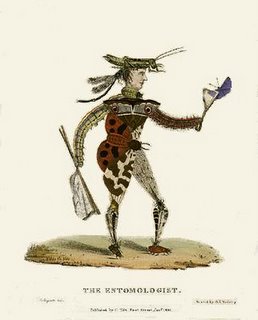My understanding is that Italian painter Giuseppe Arcimboldo created a genre by representing the human form with inanimate objects in the 16th century - some of which included tradesmen.
At the end of the 17th century Nicolas de l'Armessin (one of them: there were a few artisans by that name) engraved a series of plates - Costumes Grotesques - in which tradesmen and their occupations were depicted with the tools of their trade as body parts.
In 1730 Martin Engelbrecht released his series of similar figures to de l'Armessin (Assemblage nouveau des manouvries habilles).
During the 19th century when the idea of physiognomy - judging characters by their physical appearance (eg. phrenology) - had its greatest following, English lithographic artists GE Madeley and G Spratt released another series (itself after Cooke's 'Implemental Characters') of occupation prints. The pseudo-anthropomorphic illustrations were issued just prior to the Victorian industrial period when satirical presentation of the 'machine-age' was common.
Originally I came across an interesting engraving by Engelbrecht which sent me searching and reintroduced me to the fantastical images by de l'Armessin, one of which was included among the antique glasses engravings link I posted a couple of weeks ago. I had seen some of them before but had resisted posting until now because most of the online images were posters with gaudy colouring. I much prefer the black and white illustrations of the set posted above.
- de l'Armessin black and white engravings at the Shapero Gallery - there are 4 pages of images followed by a page with Engelbrecht engravings.
- The Madeley series of lithographs at the Glazer Gallery (despite being a commercial gallery, I've been impressed on a number of occasions in the past with the quality of both the eclectic images they have and the extent of their research)
- de l'Armessin in colour and again and again and de l'Armessin puzzles
- Physiognomy






No comments:
Post a Comment